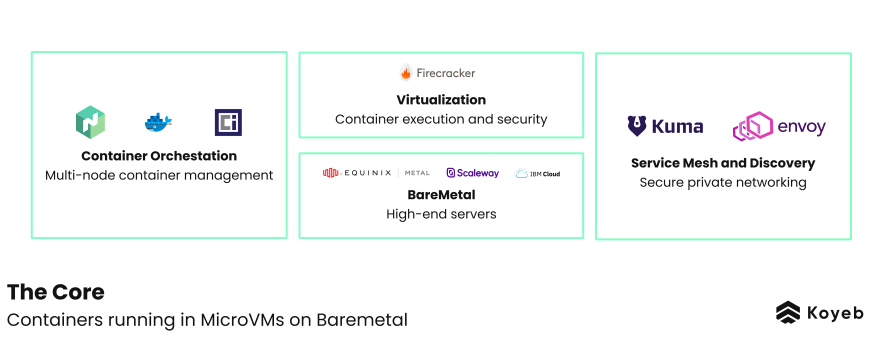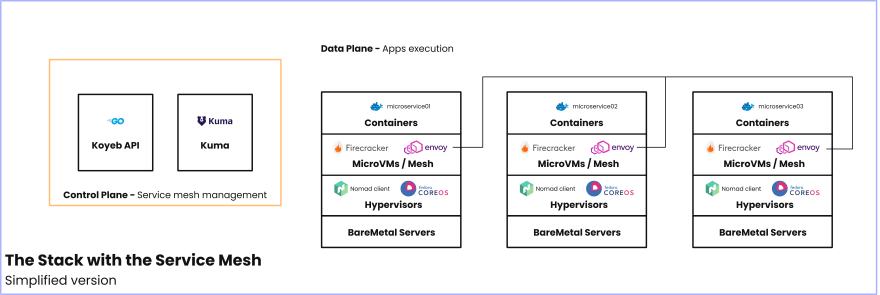72
The Koyeb Serverless Engine: from Kubernetes to Nomad, Firecracker, and Kuma
At Koyeb, our mission is to provide the fastest way to deploy applications globally. We are building a platform allowing developers and businesses to easilyrun applications, a platform where you don't need to think and deal with the
resiliency and scalability of your servers: a serverless platform.
resiliency and scalability of your servers: a serverless platform.
Ironically, a serverless platform is actually full of servers. As a cloud service provider, we operate the infrastructure for you and abstract it as much
as possible.
as possible.
The initial technological choices you make as a cloud service provider are crucial. Not only do they determine the features you can develop, but also the resiliency and scalability of your entire platform.
We decided to build our own serverless engine, one that would not be limited by existing implementations. The first version of Koyeb was built on top of Kubernetes and allowed us to quickly build a working cloud platform. After a few months of operating with this version, we decided to move user workloads from Kubernetes to a custom stack based on Nomad, Firecracker, and Kuma.
We wrote this blog post to explain why we moved from Kubernetes to a custom stack to power our users' serverless workloads. This post is written from our point of view as a cloud service provider.
Before diving into the technicals, let me outline the requirements which led us to where we are today.
At Koyeb, we are building a next-generation serverless platform that should be the fastest way to deploy applications globally. There are four core pillars we want to achieve:
Now that we have a list of requirements, let's move to the technical options.
We considered all level of abstractions to build
a full-featured platform which would be able to support our mission and requirements. We had roughly 4 options, below is the list sorted from the highest level of abstraction to the
one where you deal directly with hardware:
a full-featured platform which would be able to support our mission and requirements. We had roughly 4 options, below is the list sorted from the highest level of abstraction to the
one where you deal directly with hardware:
Our own users face the same kind of options to deploy and operate their production applications. Most of them will rule out options 3 and 4 as these are irrelevant for
most businesses nowadays.
We believe anybody who is not in the infrastructure business should try to build on top of high-level providers like Koyeb, aka option 1.
most businesses nowadays.
We believe anybody who is not in the infrastructure business should try to build on top of high-level providers like Koyeb, aka option 1.
We quickly ruled out racking servers (option 4). We've been in the business of racking and even building BareMetal servers
before but there are now enough options to pick from, at least for our current needs. In 2021, building software usually involves relying on a cloud service provider. We are no exception to that as we are building a cloud service provider on top of other cloud service providers.
before but there are now enough options to pick from, at least for our current needs. In 2021, building software usually involves relying on a cloud service provider. We are no exception to that as we are building a cloud service provider on top of other cloud service providers.
We also ruled out building on top of high-level abstractions of cloud service providers (option 1) since it doesn't provide the control we need.This option would probably allow us to develop features faster, but our platform would suffer from the same product limits as these abstractions. Since our goal is to remove these limits to improve our users' deployment experience, this choice would be counter-productive.
With this in mind, we started to build on top of Kubernetes, believing this would be the right abstraction layer to quickly build a reliable platform meeting our requirements. Spoiler alert, after several months we decided to build a purpose-built solution instead...
At Koyeb, we have been operating Kubernetes clusters for two years now and, once we started to support custom user functions and containers, we began to see limits.
Here is a broad overview of the limits we started to hit:
Back in the early 2010s, the hype was more around OpenStack than Kubernetes as Docker didn't even exist, but Kubernetes is the same kind of project: an all-purpose orchestration platform.
In our experience as a cloud service provider, when you work with large general-purpose software projects, you tend to
hit the same issues:
hit the same issues:
Don't get me wrong, Kubernetes definitely helped us develop quickly the first generations of the Koyeb engine. The ability to deploy pre-written Helm Charts is a powerful tool to deploy existing software.
As a cloud service provider, we knew we would eventually hit the limits and would either need to deep dive into Kubernetes and contribute inside its core or design the Koyeb platform differently...
With all these limits in mind, we started to re-design the platform to support our goals.
After some testing, we decided to build our serverless platform using a combination of powerful technologies. Enter Nomad, Firecracker, and Kuma on BareMetal... and Kubernetes.
After some testing, we decided to build our serverless platform using a combination of powerful technologies. Enter Nomad, Firecracker, and Kuma on BareMetal... and Kubernetes.

To understand why we combined these technologies, let's take a step back.
On the Koyeb platform, there are two key parts:
On the Koyeb platform, there are two key parts:
On each hypervisor of the data plane, there are 4 major elements:

And the Control Plane runs on... Kubernetes. As we cannot run the Koyeb Control Plane on Koyeb to avoid circular dependencies, we run the APIs on top of Kubernetes.
We selected Nomad to do the orchestration because compared to Kubernetes it is:
We've written about Firecracker MicroVMs in a previous blog post if you want to dive deeper.
The key benefits are:
There are a few more benefits that we go over in detail in our post 10 Reasons Why We Love Firecracker MicroVMs.
We built Koyeb to host distributed and microservice architectures. Distributed architectures need a way to connect the services that run within them. A service mesh is the dedicated infrastructure layer that is responsible for the secure, quick, and reliable communication between services in containerized and microservice applications.
For more information about service meshes, check out our post on service meshes and microservices.
For more information about service meshes, check out our post on service meshes and microservices.
Kuma is a rare service mesh that is not tightly coupled to its workload scheduler. This distinguishes it from alternative service meshes like Linkerd and Istio, which only work on Kubernetes. Moreover, Kuma supports multi-zone and cloud-agnostic out of the box.

The Kuma control plane allows us to secure, observe, and manage the microservice network. Next to each service instance on Koyeb is an Envoy Proxy. These proxies form the data plane, which connects to the Kuma control plane.
Proxies are configured from the control plane, meaning the hostnames your instances should know for DNS, their retry policies, and more are all communicated to the proxy from the control plane.
Kuma and Envoy provide us with a great option for private networking, especially because they:
We built Koyeb to be a secure and powerful serverless platform that is developer-friendly. Providing this serverless experience entails running multi-tenant workloads on bare metal servers in a secure and resource-efficient manner.
Moving from Kubernetes to a customized stack of Nomad, Firecracker, and Kuma enables us to provide the serverless experience we envision for the serverless future.
Moving from Kubernetes to a customized stack of Nomad, Firecracker, and Kuma enables us to provide the serverless experience we envision for the serverless future.
You can use Koyeb to host web apps and services, Docker containers, APIs, event-driven functions, cron jobs, and more. At the moment, the platform has built-in Docker container deployment and git-driven deployment is on the way!
Discover the serverless experience and by signing up today. Also, feel free to join us over on Slack.
And if you want to help build a serverless cloud service provider and dive deeper into these technologies, we're hiring!
72
